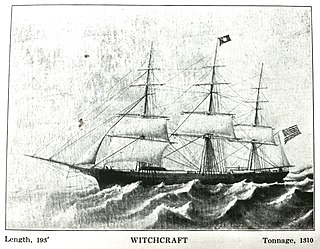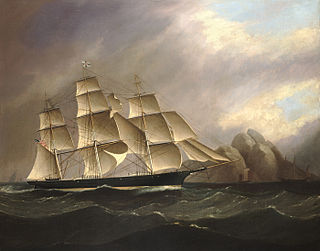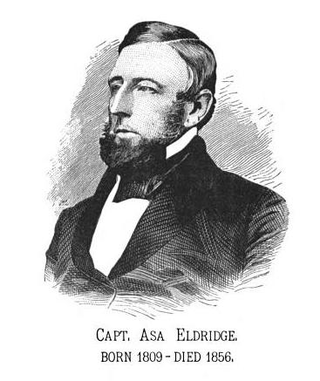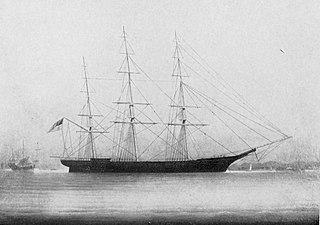
Marco Polo was a three-masted wooden clipper ship, launched in 1851 at Saint John, New Brunswick. She was named after Venetian traveler Marco Polo. The ship carried emigrants and passengers to Australia and was the first vessel to make the round trip from Liverpool in under six months. Later in her career, the ship was used as a cargo ship before running aground off Cavendish, Prince Edward Island, in 1883.

Lightning was a clipper ship, one of the last really large clippers to be built in the United States. She was built by Donald McKay for James Baines of the Black Ball Line, Liverpool, for the Australia trade.

When launched in 1853, Great Republic was the largest wooden ship in the world. She shared this title with another American-built ship, the steamship Adriatic. She was also the largest full-rigged ship ever built in the United States. She was built by Donald McKay for trade on his own account to Australia.

Edward Knight Collins I was an American shipping magnate.
The Collins Line was the common name for the American shipping company started by Israel Collins and then built up by his son Edward Knight Collins, formally called the New York and Liverpool United States Mail Steamship Company. Under Edward Collins' guidance, the company grew to be a serious competitor on the transatlantic routes to the British Cunard shipping company.

SS Pacific was a wooden-hulled, sidewheel steamer built in 1849 for transatlantic service with the American Collins Line. Designed to outclass their chief rivals from the British-owned Cunard Line, Pacific and her three sister ships were the largest, fastest and most well-appointed transatlantic steamers of their day.

The Young America was built by William H. Webb of New York. She was launched in 1853, at the height of the clipper construction boom. She sailed in the California trade, on transatlantic routes, and made voyages to Australia and the Far East.

Witchcraft was a clipper built in 1850 for the California and China trade. She made record passages from Rio de Janeiro to San Francisco, and from San Francisco to Callao, Peru.

Carrier Dove was an 1855 medium clipper. She was one of two well-known clippers launched in Baltimore that year, the other being Mary Whitridge.

The Memnon was the first clipper ship to arrive in San Francisco after the Gold Rush, and the only clipper to arrive in San Francisco before 1850. Built in 1848, she made record passages to San Francisco and to China, and sailed in the first clipper race around Cape Horn.

Ocean Telegraph was a clipper ship that was built in Massachusetts in 1854 and was last known of in Gibraltar in 1923. She was in US ownership until 1863, when UK interests bought her and renamed her Light Brigade.

The Blue Jacket was an 1854 medium clipper well known for the lavish decoration of the staterooms and saloon. She served in the Liverpool and Australia trades. The ship was named after the blue jackets, a traditional name for sailors in the US and British navies.

Comet was an 1851 California clipper built by William H. Webb which sailed in the Australia trade and the tea trade. This extreme clipper was very fast. She had record passages on two different routes: New York City to San Francisco, and Liverpool to Hong Kong, and beat the famous clipper Flying Dutchman in an 1853 race around the Horn to San Francisco.

Asa Eldridge (1809–1856) was a sea captain from Yarmouth, Massachusetts. In 1854, Captain Eldridge guided the clipper ship Red Jacket from New York and to Liverpool in only in 13 days, 1 hour, and 25 minutes, dock to dock, setting a speed record for the fastest trans-Atlantic crossing by a commercial sailing vessel that has remained unbroken ever since. In 1856, Captain Eldridge skippered the ill-fated steamship SS Pacific, which disappeared at sea on a voyage from Liverpool to New York.

Orient was a wooden-hulled, three-masted sailing ship that was built in England in 1853 and scrapped in Gibraltar in 1925. She served in the Crimean War, and then spent two decades with James Thompson & Co's "Orient Line" of ships sailing between Great Britain and South Australia.
Lord William Bentink was launched in 1828 at Yarmouth. She made one voyage transporting convicts to Tasmania, and three carrying settlers to New Zealand for the New Zealand Company. She was wrecked between 1858 and 1859.

The SS Schomberg was a clipper built in Aberdeen by Alexander Hall & Co. for "the Black Ball line" for carrying large cargoes and steerage passengers, and to "outdo the Americans". When built, she was regarded as the most luxurious and well-built clipper of the period.

Gravina was an 818-register ton clipper ship built in Hoboken, New Jersey, in 1853. A rare example of a clipper built in the United States for foreign owners, Gravina was originally homeported in Spain, though commanded by an American.

Donald McKay was an extreme clipper designed by Donald McKay, his last. Built for James Baines & Co., she sailed on the Black Ball Line of Liverpool from 1855 to 1868, carrying passengers and mail between England and Australia.
Lalla Rookh was a square-rigged, iron-hulled tea clipper of 869 tons, built in 1856 in Liverpool, Lancashire, owned by William Prowse & Co. and said to travel fast. She was used for trade with India and China, and was advertised in 1871 as a packet ship to take passengers to Australia. She was completely wrecked at Prawle Point, Devon on 3 March 1873, with the loss of one crew member and all of her cargo of tea and tobacco.

















